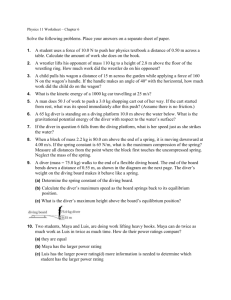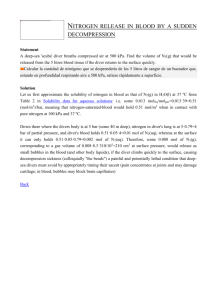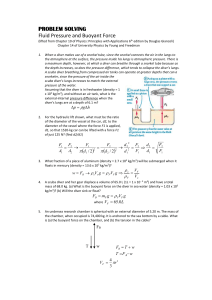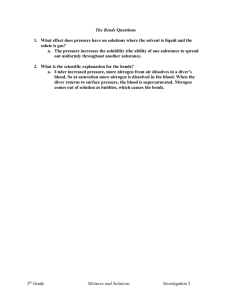Respiration Physiology and Oxygen Toxicity
advertisement
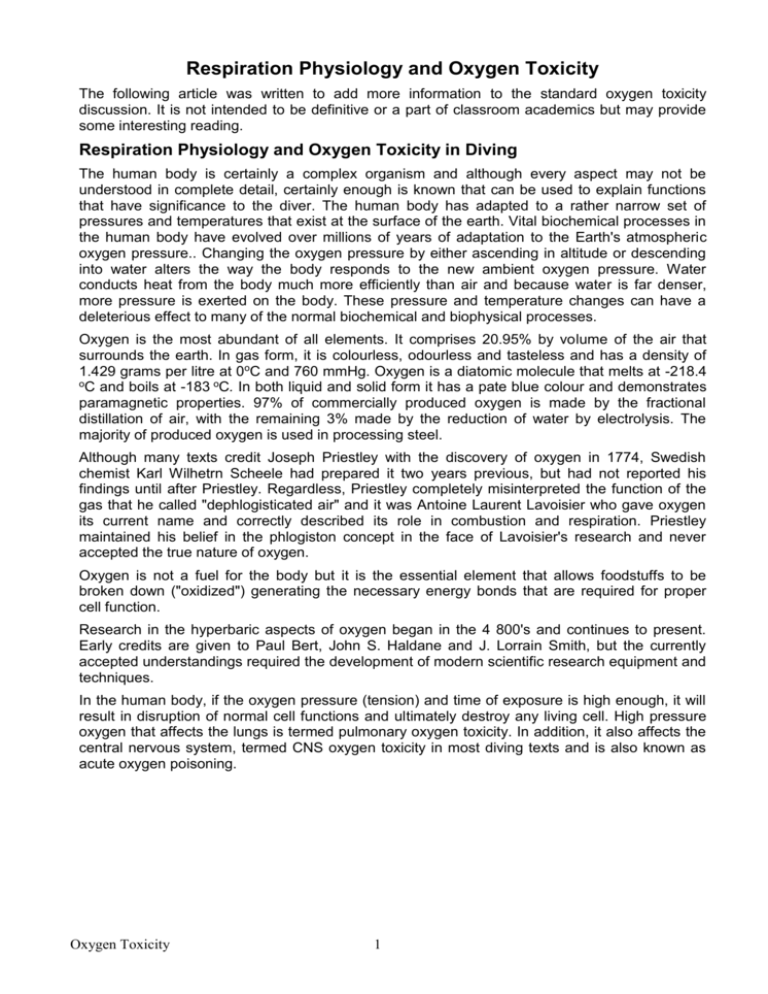
Respiration Physiology and Oxygen Toxicity The following article was written to add more information to the standard oxygen toxicity discussion. It is not intended to be definitive or a part of classroom academics but may provide some interesting reading. Respiration Physiology and Oxygen Toxicity in Diving The human body is certainly a complex organism and although every aspect may not be understood in complete detail, certainly enough is known that can be used to explain functions that have significance to the diver. The human body has adapted to a rather narrow set of pressures and temperatures that exist at the surface of the earth. Vital biochemical processes in the human body have evolved over millions of years of adaptation to the Earth's atmospheric oxygen pressure.. Changing the oxygen pressure by either ascending in altitude or descending into water alters the way the body responds to the new ambient oxygen pressure. Water conducts heat from the body much more efficiently than air and because water is far denser, more pressure is exerted on the body. These pressure and temperature changes can have a deleterious effect to many of the normal biochemical and biophysical processes. Oxygen is the most abundant of all elements. It comprises 20.95% by volume of the air that surrounds the earth. In gas form, it is colourless, odourless and tasteless and has a density of 1.429 grams per litre at 0oC and 760 mmHg. Oxygen is a diatomic molecule that melts at -218.4 oC and boils at -183 oC. In both liquid and solid form it has a pate blue colour and demonstrates paramagnetic properties. 97% of commercially produced oxygen is made by the fractional distillation of air, with the remaining 3% made by the reduction of water by electrolysis. The majority of produced oxygen is used in processing steel. Although many texts credit Joseph Priestley with the discovery of oxygen in 1774, Swedish chemist Karl Wilhetrn Scheele had prepared it two years previous, but had not reported his findings until after Priestley. Regardless, Priestley completely misinterpreted the function of the gas that he called "dephlogisticated air" and it was Antoine Laurent Lavoisier who gave oxygen its current name and correctly described its role in combustion and respiration. Priestley maintained his belief in the phlogiston concept in the face of Lavoisier's research and never accepted the true nature of oxygen. Oxygen is not a fuel for the body but it is the essential element that allows foodstuffs to be broken down ("oxidized") generating the necessary energy bonds that are required for proper cell function. Research in the hyperbaric aspects of oxygen began in the 4 800's and continues to present. Early credits are given to Paul Bert, John S. Haldane and J. Lorrain Smith, but the currently accepted understandings required the development of modern scientific research equipment and techniques. In the human body, if the oxygen pressure (tension) and time of exposure is high enough, it will result in disruption of normal cell functions and ultimately destroy any living cell. High pressure oxygen that affects the lungs is termed pulmonary oxygen toxicity. In addition, it also affects the central nervous system, termed CNS oxygen toxicity in most diving texts and is also known as acute oxygen poisoning. Oxygen Toxicity 1 Pulmonary oxygen toxicity is related to exposures over a long period of time and as a result is typically found only during recompression therapy in normal recreational-technical divers. Pulmonary oxygen toxicity is referred to by a variety of names, chronic oxygen toxicity, whole body oxygen toxicity, etc. It is otherwise limited to such activities as saturation diving and possibly long oxygen rebreather dives, which are only common to commercial or military diving operations. Of significant importance to the recreational-technical diver however, is the definite possibility of experiencing the conditions that would lead to acute oxygen poisoning, Central Nervous System Oxygen Toxicity. As might well be imagined, if any condition involves the central nervous system, it can be serious and warrants significant attention and detail by the diver. CNS oxygen toxicity usually does not occur unless inspired oxygen pressures approach 1-6ATA (atmospheres absolute), however symptoms have been noticed at oxygen exposures as low as 1.3 ATA in certain exceptional conditions. Symptoms have been classically described in diving literature using the mnemonic "VENTID", representing Vision, Ears, Nausea, Twitching, Irritability, Dizziness and Tingling. Each of these symptoms are sometimes difficult to recognize in early stages while diving and are also confusing in light of other diving maladies that have similar effects, such as nitrogen narcosis. By themselves, these symptoms do not have any serious effect on the diver. However, if the exposure to high pressure oxygen continues, it may result in the most serious situation whereby the diver would experience a convulsion or grand ma1 seizure. This has led some writers to include convulsion in the mnemonic and modify it to ConVENTID; however, the convulsion is clearly not a symptom to the diver but rather a "sign"to the diver's buddy! While the acronym has made for tots of discussion and numerous written test questions, it has little practical value in actual diving activities. Complicating the situation is that in many, if not most, cases, an oxygen convulsion may occur without any warning or recognition of symptoms by the stricken diver The primary action of a recreational technical diver is centred on prevention of CNS oxygen toxicity, rather than recognition of any symptoms. As far as being aware of symptoms, the cardinal rule of technical diving should always centre on the phrase "lf anything seems wrong, It is wrong”. With this suspicion, the dive is aborted, or as a minimum moved to a shallower depth, to remove the effect of high ambient pressure on the situation. In general, technical divers should always think in terms of ambient pressure, the "absolute pressure", in "atmospheres absolute". It is this pressure that drives virtually all biochemical and biophysical reactions. In addition, it also modifies physical elements of the dive, such as reducing volume, increasing gas density as well as causing compression of insulating materials. Central Nervous System Oxygen Toxicity is dealt with by divers through prevention only, not by trying to recognize symptoms Underscoring prevention as the primary technique of dealing with acute oxygen toxicity is that brain wave (electroencephalogram) (EEG) studies showed there were no changes to predict the onset of a convulsion. A variety of organizations, U.S. Navy, NOAA, DCIEM, commercial diving organizations, etc, have constructed exposure charts based on empirical data with the NOAA chart being the most commonly used in recreational-technical diving. It is not based on a particular formula, but rather experience. Oxygen Toxicity 2 It is best to consider oxygen as a drug and as such the effect of oxygen is based on two factors, concentration and time of exposure. Dose is technically the amount or quantity of oxygen over time, however most diving articles describe "dose" in terms of pressure, i.e. ATA. EAN40 (40 percent oxygen) at 30 MSW, home of 4 atmospheres absolute (ATA) of ambient pressure, will result in an oxygen dose rate (pressure) of 1.6ATA. From the NOAA chart, 1.6ATA is considered the maximum oxygen dosage in normal conditions. Exceptional exposures are shown in NOAA and USN charts only for emergency or life saving conditions, not for casual use by recreationaltechnical divers. Bounce dives to depths where oxygen pressures exceed the recommended oxygen pressure of 1-6 ATA are frequently condemned, however, there is little if any evidence to suggest these short duration exposures represent an oxygen risk. Numerous studies have shown short (3to 5 minute) exposures of exceptionally high oxygen pressure to be tolerated without convulsion. Remember however, if the diver has already had a period of high pressure oxygen exposure before the short dive, there can be residual oxygen tension that may push the diver over the body's tolerance level. On the other hand, when diving with normoxic air, at excessive depth, the narcotic value of the inspired gas will cause an anaesthesia-like disability. That is the true hazard to deep air bounce dives. Prevention Techniques Preventing oxygen toxicity problems requires the following factors: proper pre- dive planning, accurate analysis of the associated breathing gases and proper monitoring and adherence to the dive plan. If the diver cannot comply with these requirements, they should consider taking up bungee jumping, hang gliding or javelin catching and not jeopardize the other members of a dive team. Oxygen Transport Systems Oxygen is necessary to support Iife and is delivered to the various tissues of the body via two systems, the respiratory system and the circulatory system. The respiratory system can be divided into two components, the external mechanisms and the internal mechanisms. Internal respiration occurs at the mitochondria (cellular level), where metabolism of food takes place with oxygen as the oxidizing agent, producing energy bonds, water and carbon dioxide. The external part consists of the mouth, the trachea which branches to two major bronchi, which further subdivide approximately 20 to 24 times resulting in 1to 8 million terminal tubes. At the end of these tubes are clusters of small sacs termed “alveoli" where the actual gas exchange process occurs. There are approximately 300 million of these sacs in normal human lungs. Although the sizes of the alveoli are small, ranging from 75 to 300 micrometers in diameter, the large number results in a surface area about 70 square meters, or roughly the size of half a tennis court. A normal sized person at rest breathes about 4 litres per minute while at high work rates it may increase 30 to 40 times. The heart circulates about 4 to 5.5 litres of blood per minute that may increase 5 to 6 times during high exercise. Oxygen Toxicity 3 The alveoli are in intimate contact with the circulatory system. The thickness of the alveolus sac, in other words the separation between air and blood, is on the order of a single micron. Blood is transported throughout the body to properly oxygenate tissues to support cellular function and life. Blood returning from the body is directed to the right atrium of the heart then into the right ventricle that then pumps blood to the left and fight pulmonary arteries. These arteries conduct the blood to the left and right lung respectively branching to the pulmonary capillaries, where the gas exchange takes place. Blood is made up of a variety of components, with oxygen and carbon dioxide being transported by haemoglobin. Molecular oxygen crosses the alveolar membrane to the blood by the process of diffusion white carbon dioxide, the "waste product" of metabolism, moves in the opposite direction to be exhaled from the lungs. Incidentally, carbon dioxide transport is more complicated than just attaching to haemoglobin, involving a variety of biochemical changes. Only about 5 percent of carbon dioxide is transported via haemoglobin, another 5 percent by physical solution in accordance with Henry's taw. The majority of carbon dioxide, 90%,is carried in the form of HCO; ions. The oxygen that diffuses to the blood is bound to the haemoglobin component and is then directed to the left atrium of the heart via the left and right pulmonary veins, from the left and right lung respectively. From the left atrium, the blood moves to the left ventricle and is pumped into arteries, which branch to arterioles and further branch to the capillary bed throughout the body. The oxygen is released from the higher pressure to the lower pressure areas and eventually enters the mitochondria to be used in the internal respiration process. Carbon dioxide is picked up as the oxygen exchange at the cellular level occurs, and the "used" blood returns via veins to the right atrium, to start the process over again. A significant amount of discussion centres on various conditions that may contribute to decompression illness, one in current vogue is patent foramen ovale (PFO). Everyone has a PFO during foetal development, however some fail to seal completely after birth and this allows venous blood to shunt directly to the arterial side without going through the lungs. interestingly enough, what isn't often mentioned (if at all) is that even in normal healthy individuals there exists about 2% of the blood that passes through the lung but bypasses the effective gas exchange process and is known as the "Fight-left shunt" (R-L shunt) (venous admixture). It is possible that this has been taken out of consideration by the empirical adjustment of dive tables. In any event, there are also a myriad of coronary diseases that can significantly increase the magnitude of this R-L shunt. The pressure of oxygen that finally reaches the mitochondria in a normal human is significantly less than the oxygen pressure in air. While divers typically think of pressures in terms of atmospheres, medical texts use millimetres of mercury (mmltrs). Standard atmospheric pressure is 760 mmHg, so at 20.95 percent oxygen, the oxygen pressure is 159 mmHg. In a normal human at rest, the air enters the mouth at an oxygen pressure of 159 mmHg, combining with water vapour in the trachea, reducing down to 149 mmHg. From there the alveolar gas oxygen pressure reduces to about I00 mmHg, pulmonary venous blood is about 96 mmHg, arterial blood is about 92 mmHg following the venous admixture R-L shunt. Finally at the mitochondria the oxygen pressure is any between 1 and 3 mmHg. Returning mixed venous blood typically has oxygen pressures in the vicinity of 40 mmHg. The body controls the tissue oxygen pressure to a normally safe range of 20-60 mmHg by a variety of buffer mechanisms and the action of the haemoglobin-oxygen dissociation curve. In normal conditions, almost none (3% or less) of the oxygen is dissolved, but rather bound to haemoglobin. Oxygen Toxicity 4 Even at normal oxygen levels (pressure/ tension) there is a naturally occurring biochemical process in which a certain number of oxygen "free radicals" are continuously produced which could be disruptive to cellular function. Among these include the super oxide anion 02-and hydrogen peroxide (H202). Hydrogen peroxide is not a free radical but rather a cytotoxic (destructive to cells) compound. Most of the oxidant damage to cells are not due to the super oxide anion or hydrogen peroxide, but rather they contribute to the production of more reactive species. Cells fortunately contain a group of enzymes that rapidly buffer and remove these radicals. These enzymes are typically catalases, perioxidases and super oxide dismutases. Therefore, as long as the haemoglobin-oxygen buffering keeps the tissue oxygen concentration within normal ranges the oxidizing free radicals will be removed quickly enough to prevent damage to the tissues. Acute Oxygen Toxicity Effects Under hyperbaric conditions, only so much oxygen can be combined and transported by the haemoglobin. Excess oxygen is mechanically dissolved in other blood fluids such as plasma and carried through the circulatory system much like diluents gases such as nitrogen and helium. In general, despite this potential excess oxygen, it has typically not been implicated in any form of decompression sickness, other than middle ear oxygen absorption syndrome. The increase in oxygen pressure can be detrimental to many of the body's tissues. The tissues of the brain tend to be more susceptible than other organs and are also affected by lower oxygen pressures that may result in oxygen seizure and convulsion. As the haemoglobin-oxygen buffer mechanism fails, the protective enzyme systems are overwhelmed by the oxidizing free radicals and hydrogen peroxide. This results in damaging or even lethal effects to the cell. One of the effects is to oxidize the polyunsaturated fatty acids that make up the membranous structures of the cells as well as the cellular enzymes that can severely damage the metabolic system. Nerve tissues, particularly brain tissue, are especially susceptible because of the high lipid content, which results in brain dysfunction many times being the first problem to occur. Blood-Brain Barrier One of the many remarkable defence mechanisms that the body has is the "blood-brain barrier" and the 'blood-cerebrospinal fluid barrier". The diffusion of substances throughout the body are significantly different to that inthe brain. The capillary bed of the brain allows easy diffusion of oxygen, carbon dioxide, water and those substances that are lipid-soluble such as alcohol and anaesthetics. The blood-brain barrier is slightly permeable to electrolytes such as chlorides, potassium and sodium. It is almost totally impermeable to plasmas and non-lipid soluble large organic molecules. The existence of the blood-brain and bloodcerebrospinal barriers has thwarted medical researchers when trying to develop therapeutic drugs such as antibiotics for those regions. This very same barrier necessarily precludes divers from using prophylactic drug therapy such as oral GABA or any of a myriad other things. The easy transport of excessive oxygen to the brain tissues though the blood-brain barrier may help explain why the deleterious effects manifest as a grand ma1 seizure type of convulsion rather than in some other organ of the body. Influence of Food Supplements and Medications Some have tried to associate "cause and effect" relationships to the onset of acute oxygen toxicity, such as the reduction of GABA (Gamma-Aminobutyric Acid). While there may be some benefit to prophylactic use of Vitamin E and some Vitamin C in order to improve the body's antioxidant defence mechanisms, that remains largely anecdotal and unsupported by testing. The body can store Vitamin E; unfortunately it tends not to be transported to the brain cells. Oxygen Toxicity 5 Vitamin C is not stored in the body and any excess to the biochemical needs is simply pushed overboard in urine. Attempts to improve antioxidant defences may contribute some potential benefit, however the true mechanism should be understood before ingesting huge quantities of tree bark. For example, oral GABA is simply broken down into its constituent amino acids and is not transferred to the cells. It should be further noted that all neurotransmitters (GABA is an inhibitory neurotransmitter) are generated in the presynaptic neurons and not transported in thru the circulatory system. Regardless, unless the blood-brain barrier will allow transfer across the membrane, this will preclude any direct benefit that may be thought to be beneficial. Some drugs that were used to boost certain enzymes would actually promote seizure activity while other drugs are contraindicated for reasons not associated with their effect on oxygen toxicity. A diver would be better served to eat a healthy diet that allows cells to function normally, avoid habits of alcohol and tobacco, and quit worrying about which pill or supplement to take next. Then again, so would non-divers. Oxygen Convulsion The immediate response to an oxygen convulsion should be to remove the stricken patient or diver from the condition of high ambient oxygen pressure. The seizure that occurs in acute oxygen toxicity conditions is essentially identical with those associated with grand ma1 epilepsy. The sudden onset of the oxygen convulsion occurs with stricken diver loosing consciousness. The brain dysfunction sends out a multitude of new impulses to the muscles and at the peak of the seizure, all of the muscles may be stimulated simultaneously. This causes a rigid muscle lock-up termed the 'tonic phase". The neck undergoes a powerful extension as well as all four extremities. As the brain tires, typically around 30 seconds, the rate of stimulation to the muscles slows signalling the beginning of the “tonic phase". During this phase the diver may severely jerk and thrash typically for about a minute before gradually ending. During the tonic and clonic periods the diver is apnoeic (not breathing) resulting in significant retention of carbon dioxide. The convulsion is followed by a period of rapid and sometimes vigorous hyperventilation due to these high levels of carbon dioxide. As long as high pressure oxygen breathing has been terminated, the brain is left in a depressed condition (postictal), remaining unconscious for a period, then a period of semi consciousness when the diver may appear restless. Eventually the diver will regain consciousness after about 15 minutes up to an hour. The newly alert diver may complain of being tired, muscle soreness and a headache. The diver typically remembers everything up to the point of unconsciousness but nothing of the convulsion. The diver may have vague or spotty recollections of the restless period. It must be noted, that once the biochemical changes associated with acute oxygen toxicity have begun they are not instantly reversible by simply changing to a breathing gas that has a lower oxygen pressure. Think of a freight train applying the brakes, it may not begin to slow for several minutes, thusly a diver is still at risk of convulsion for two to three minutes following the reduction in oxygen pressure. This is sometimes referred to as the "off oxygen" effect, but there has been no evidence to suggest that the convulsion is hastened or promoted by switching to tower oxygen pressure concentrations. Oxygen Toxicity 6 There can be a considerable range in susceptibility among divers but even a diver can have varying degrees of reaction depending on conditions such as carbon dioxide pressure, hydration and temperature. Carbon dioxide is necessary in that it provides the respiratory drive, however it is only beneficial at specific concentrations (tensions). As carbon dioxide pressure increases, the rate of respiration increases, which in conditions of high oxygen pressure keeps the arterial oxygen pressure at dangerous levels. High levels of carbon dioxide have been shown to exacerbate the effects of both oxygen toxicity as well as nitrogen narcosis, not to mention it can cause a severe headache in lieu of other hazards. Acute Oxygen Toxicity (CNS) Convulsion Underwater The immediate concern associated with an acute oxygen toxicity convulsion underwater is the prevention of drowning. The diver that observes an oxygen convulsion underwater will live nine lifetimes in the few critical minutes of the event. Fortunately, underwater occurrences are rare and hopefully through continued education, they may be eliminated entirely. A number of recommendations have been made by a variety of sources, but an examination of the convulsive condition gives the best hint as to the course of action. There are pros and cons to any action taken, so just keep your mind as calm as possible under the circumstances. Good luck. The U.S. Navy guidelines are to keep the stricken diver at a constant depth until breathing resumes. During the tonic / clonic phases of the oxygen convulsion, the stricken diver is not breathing. It follows that there might be a significant risk of embolism if ascent is started or continued. On the other hand, the only impediment between the lungs and the mouth is the epiglottis, a cartilage barrier with connecting tissues that is controlled by muscles. It is not clear or predicable what position the epiglottis will be in during the tonic / clonic phase, so if the mouth is open it may be argued that it would be better to continue the ascent. Some believe that as long as it is safely possible, the stricken diver can be held at the depth where the convulsion began. Because of the thrashing that is associated with the clonic phase, it would be best to hold the stricken diver from behind, keeping the regulator in place. Be sure to keep your head away from the back of the stricken diver's head as it could hyperextend during the clonic phase. This is a standard rescue position anyway and should not represent a particularly difficult task but be careful and wary. Being in water, some of the violent movements may well be slowed and represent less risk than those convulsions that occur in air. Following the clonic phase, rapid breathing will begin and an ascent to the surface can be made without risk of embolism. Ascend at a normal rate and forget about safety stops. The "buddy" may want to consider breathing oxygen in the event any safety stops or decompression obligations were skipped, but the stricken diver should breathe normoxic air. The stricken diver should be treated as if arterial gas embolism is present and transported to appropriate medical facilities. After complete consciousness has been regained, and there is reason to suspect DCI (either decompression sickness or arterial gas embolism (AGE) involvement, the victim may breathe oxygen. The computers or dive profiles should be collected to travel with the patients. If a member of a cave diving team experiences a CNS convulsion during the dive phase, as opposed to the decompression phase, then it is left to the best judgment of the team members how to proceed. Do not endanger yourself or other team members in any case. If it is any consolation, they should remember those immortal words -"it sucks to be you". If a diver experiences the convulsion during in-water decompression, they should be surfaced after the tonic/clonic phase and transported to an appropriate recompression facility. They should not be returned to the water in as much as full consciousness may not be regained for up to an hour. Returning to the water is risky in any event, even if the stricken diver appears to be recovered Oxygen Toxicity 7 The use of a full face mask during hyperoxic exposures has some benefit in reducing drowning, however it should be noted, unless the hyperoxic mixture is not replaced, the convulsive series will begin again with much shorter onset times. In the event the diver is not breathing upon surfacing, standard BCLS/ACLS procedures should be followed. Pulmonary Oxygen Toxicity In general, as previously stated, the exposure to low doses of oxygen pressure that causes pulmonary oxygen toxicity is simply not a practical concern for normal recreational technical divers. This is primarily due to the long exposure times required before the biochemical changes manifest themselves in a deleterious manner. A person can be exposed to an oxygen pressure of I ATA almost indefinitely without experiencing any CNS oxygen toxicity symptoms or signs. After about 12 hours of the same exposure however, pulmonary symptoms may begin. Typical symptoms of chronic pulmonary oxygen toxicity begin with a burning in the chest during inspiration eventually leading to a painful condition. This is characterized by pulmonary oedema, congestion of the lung passageways and atelectasis (loss of lung volume, shown in some texts as "loss of vital capacity"). Damage to the bronchi and alveoli develop due to its continuous direct contact with the high pressure oxygen but the condition does not affect other tissues because of the haemoglobin-oxygen buffer system. When a patient experiences pulmonary oxygen toxicity effects during recompression therapy, they are treated symptomatically with a variety of drugs. Following return to normoxic pressure levels, vital capacity recovery is observed within 5 hours of removal from the high oxygen environment with virtually complete recovery in 15 to 30 hours. Summary The very nature of the human physiological processes makes easily scripted explanations virtually impossible. Many aspects of circulation and respiration have been left out of this article while concentrating on the portions that seem most likely to be causative to oxygen toxicity events. It is evident that oxygen toxicity does not really have a "latent" period, but rather increases the biochemical action immediately upon the elevation of ambient oxygen pressure. A person remains asymptomatic until such time as enough of the body's defence mechanisms and buffers have been overwhelmed. This is based on the oxygen pressure (tension) and the time of exposure. There exists a number of charts that define various oxygen exposures and allowable time of exposure. These charts are satisfactory for normal usages but the maximum exposures and times should be reduced if dives of heavy work or excessively cold water are anticipated. Divers should always remember that PREVENTION is the only sure technique of coping with oxygen toxicity events Oxygen Toxicity 8
